Modernizing District Heating Networks: A Strategic Decision-Support Framework for Sustainable Retrofitting
Abstract
1. Introduction
- RQ1: What are the potential action fields of a strategy to modernize district heating in a municipality?
- RQ2: Which measures are indicated to implement these strategic directions in different contexts?
- RQ3: How should practitioners prioritize retrofitting measures?
2. Materials and Methods
3. Results
3.1. Action Fields for the Modernization of District Heating Systems
3.2. Strategic Directions
3.3. Strategic Decision-Support Framework
- Supply-Side Strategies: fuel diversification, thermal energy storage (TES) integration, and district heating network retrofitting and expansion.
- Demand–Side Strategies: smart metering infrastructure and implementation of financial incentives for customers.
- Policy Frameworks: government support, policy advocacy, and public outreach.
- Benefit dimension evaluation, which includes four different subcategories: customer value, business value, ecosystem value, and public and social value.
- Cost dimension evaluation, which includes two different subcategories: CAPEX/OPEX and transaction costs.
3.4. Illustrative Testing and Conceptual Refinement of the Strategic Decision-Support Framework
3.4.1. Illustration of Benefit and Cost Dimension
3.4.2. Portfolio Visualization
3.4.3. Summary of Expert Feedback
4. Discussion
4.1. A Strategic View of DH Modernization
4.2. Implications for Policy and Practice
- Potential Investors: Potential investors include local utility companies, government bodies, and private sector investors with an interest in enhancing the efficiency and sustainability of district heating networks. Government and municipal bodies are particularly well-positioned to support such projects due to their alignment with public policy goals related to energy efficiency and greenhouse gas emission reductions (see also [81]).
- Opportunities and Risks: The opportunities associated with such a P&D project include the scalability across other regions, potential cost savings from improved efficiency, and enhanced integration of renewable energy sources. However, risks such as technical challenges, high upfront investment costs, and consumer acceptance issues need to be carefully managed through robust planning and stakeholder engagement.
- Designing the P&D Project: The P&D project should be designed with a focus on both engineering know-how and collaborative stakeholder involvement. Such a holistic approach ensures that the project not only demonstrates technical feasibility but also addresses economic and social dimensions, making it a viable option for broader application.
5. Conclusions
Supplementary Materials
Author Contributions
Funding
Data Availability Statement
Acknowledgments
Conflicts of Interest
Abbreviations
| 4GDH | 4th generation district heating |
| CAPEX | Capital expenditure |
| CBA | Cost–benefit analysis |
| CEBEP | Coevolutionary business ecosystem perspective |
| DH | District heating |
| OPEX | Operational expenditure |
| P&D | Pilot and demonstration |
| TES | Thermal storage |
| TOWS | Threats, opportunities, weaknesses, strengths analysis |
Appendix A
Appendix A.1
| Demand-Side Management Building Energy Retrofits | |||
|---|---|---|---|
| Internal factors | Strengths (S)
| Weakness (W)
| |
| External factors | |||
Opportunities (O)
| S–O strategy directions
| ||
Threats (T)
| |||
| Policy and Regulatory Framework Modernized Building Codes | |||
|---|---|---|---|
| Internal factors | Strengths (S)
| Weakness (W)
| |
| External factors | |||
Opportunities (O)
| S–O strategy directions
| ||
Threats (T)
| |||
| Policy and Regulatory Framework Research and Development | |||
|---|---|---|---|
| Internal factors | Strengths (S)
| Weakness (W)
| |
| External factors | |||
Opportunities (O)
| S–O strategy directions
| ||
Threats (T)
| |||
References
- Energy Statistics—An Overview. Available online: https://ec.europa.eu/eurostat/statistics-explained/index.php?title=Energy_statistics_-_an_overview (accessed on 7 April 2024).
- Potentials and Levels for the Electrification of Space Heating in Buildings—Publications Office of the EU. Available online: https://op.europa.eu/en/publication-detail/-/publication/2ae4481d-8f3b-11ee-8aa6-01aa75ed71a1/language-en (accessed on 20 June 2025).
- Summary for Policymakers. In Climate Change 2013—The Physical Science Basis: Working Group I Contribution to the Fifth Assessment Report of the Intergovernmental Panel on Climate Change; Intergovernmental Panel on Climate Change (IPCC), Ed.; Cambridge University Press: Cambridge, UK, 2014; pp. 1–30. ISBN 978-1-107-05799-9. [Google Scholar]
- Connolly, D.; Lund, H.; Mathiesen, B.V.; Werner, S.; Möller, B.; Persson, U.; Boermans, T.; Trier, D.; Østergaard, P.A.; Nielsen, S. Heat Roadmap Europe: Combining District Heating with Heat Savings to Decarbonise the EU Energy System. Energy Policy 2014, 65, 475–489. [Google Scholar] [CrossRef]
- Swiss Federal Office of Energy (SFOE). Heat and Cooling Demand from Industry. Available online: https://www.bfe.admin.ch/bfe/en/home/versorgung/digitalisierung/geoinformation/geodaten/thermische-netze/waerme-und-kaeltenachfrage-industrie.html (accessed on 11 July 2025).
- Element Energy. Research on District Heating and Local Approaches to Heat Decarbonisation (Report prepared for the Climate Change Committee). Climate Change Committee, 2021. Available online: https://www.theccc.org.uk/publication/element-aenergy-for-ccc-research-on-district-heating-and-local-approaches-to-heat-decarbonisation/ (accessed on 18 June 2025).
- Guelpa, E.; Mutani, G.; Todeschi, V.; Verda, V. A Feasibility Study on the Potential Expansion of the District Heating Network of Turin. Energy Procedia 2017, 122, 847–852. [Google Scholar] [CrossRef]
- Sustainable Energy Authority of Ireland (SEAI). District Heating Feasibility Study Template—How-to Guide; SEAI: Dublin, Ireland, 2025; Available online: https://www.seai.ie/sites/default/files/2025-03/district-heating-feasibility-study-template-how-to-guide.pdf (accessed on 16 June 2025).
- Sarbu, I.; Mirza, M.; Muntean, D. Integration of Renewable Energy Sources into Low-Temperature District Heating Systems: A Review. Energies 2022, 15, 6523. [Google Scholar] [CrossRef]
- Heat Roadmap Europe: Identifying Strategic Heat Synergy Regions. Available online: https://ideas.repec.org/a/eee/enepol/v74y2014icp663-681.html (accessed on 18 June 2025).
- Werner, S. District Heating and Cooling in Sweden. Energy 2017, 126, 419–429. [Google Scholar] [CrossRef]
- Werner, S. District Heating and Cooling. In Reference Module in Earth Systems and Environmental Sciences; Elsevier: Amsterdam, The Netherlands, 2013; ISBN 978-0-12-409548-9. [Google Scholar]
- Lund, J.W.; Freeston, D.H.; Boyd, T.L. Direct Utilization of Geothermal Energy 2010 Worldwide Review. Geothermics 2011, 40, 159–180. [Google Scholar] [CrossRef]
- Rezaie, B.; Rosen, M.A. District Heating and Cooling: Review of Technology and Potential Enhancements. Appl. Energy 2012, 93, 2–10. [Google Scholar] [CrossRef]
- District Heating—Energy System. Available online: https://www.iea.org/energy-system/buildings/district-heating (accessed on 24 June 2025).
- District Energy Space—International District Energy Association. Available online: https://www.districtenergy.org/resources/district-energy-space (accessed on 10 June 2025).
- Residential Buildings by Main Heating Energy Source and Canton. Available online: https://datawrapper.dwcdn.net/b4486a2ae793265675a6b8052a3a1c58/8/ (accessed on 29 January 2025).
- Swiss Federal Statistical Office (BFS). Energy Sector of Buildings. Available online: https://www.bfs.admin.ch/bfs/en/home/statistiken/bau-wohnungswesen/gebaeude/energiebereich.html (accessed on 11 July 2025).
- Swiss Federal Office of Energy (SFOE). District Heating. Available online: https://www.bfe.admin.ch/bfe/en/home/versorgung/energieeffizienz/fernwaerme.html (accessed on 11 July 2025).
- Lund, H.; Werner, S.; Wiltshire, R.; Svendsen, S.; Thorsen, J.E.; Hvelplund, F.; Mathiesen, B.V. 4th Generation District Heating (4GDH): Integrating Smart Thermal Grids into Future Sustainable Energy Systems. Energy 2014, 68, 1–11. [Google Scholar] [CrossRef]
- Guelpa, E.; Capone, M.; Sciacovelli, A.; Vasset, N.; Baviere, R.; Verda, V. Reduction of Supply Temperature in Existing District Heating: A Review of Strategies and Implementations. Energy 2023, 262, 125363. [Google Scholar] [CrossRef]
- The History of Thermal Networks in Switzerland. Available online: https://www.sweet-decarb.ch/news/article/the-history-of-thermal-networks-in-switzerland (accessed on 14 April 2024).
- Speich, M.; Chambers, J.; Ulli-Beer, S. Current and Future Development of Thermal Grids in Switzerland: An Organizational Perspective. Front. Sustain. Cities 2024, 6, 1379554. [Google Scholar] [CrossRef]
- Rämä, M.; Sipilä, K. Transition to Low Temperature Distribution in Existing Systems. Energy Procedia 2017, 116, 58–68. [Google Scholar] [CrossRef]
- International Energy Agency. Coming in from the Cold: Improving District Heating Policy in Transition Economies; OECD: Paris, France, 2004; ISBN 978-92-64-10819-6. [Google Scholar]
- Lund, H.; Østergaard, P.A.; Nielsen, T.B.; Werner, S.; Thorsen, J.E.; Gudmundsson, O.; Arabkoohsar, A.; Mathiesen, B.V. Perspectives on Fourth and Fifth Generation District Heating. Energy 2021, 227, 120520. [Google Scholar] [CrossRef]
- Weihrich, H. The TOWS Matrix—A Tool for Situational Analysis. Long Range Plan. 1982, 15, 54–66. [Google Scholar] [CrossRef]
- Bull, R.; Eadson, W. Who Has the Power? Reflections on Citizen Engagement in District Heating Schemes in the UK and Sweden. Energy Policy 2023, 177, 113505. [Google Scholar] [CrossRef]
- Speich, M.; Ulli-Beer, S. Applying an Ecosystem Lens to Low-Carbon Energy Transitions: A Conceptual Framework. J. Clean. Prod. 2023, 398, 136429. [Google Scholar] [CrossRef]
- Leviäkangas, P.; Öörni, R. From Business Models to Value Networks and Business Ecosystems—What Does It Mean for the Economics and Governance of the Transport System? Util. Policy 2020, 64, 101046. [Google Scholar] [CrossRef]
- Ommen, T.; Markussen, W.B.; Elmegaard, B. Lowering District Heating Temperatures—Impact to System Performance in Current and Future Danish Energy Scenarios. Energy 2016, 94, 273–291. [Google Scholar] [CrossRef]
- Vannahme, A.; Ehrenwirth, M.; Schrag, T. Enhancement of a District Heating Substation as Part of a Low-Investment Optimization Strategy for District Heating Systems. Resources 2021, 10, 53. [Google Scholar] [CrossRef]
- Sporleder, M.; Rath, M.; Ragwitz, M. Design Optimization of District Heating Systems: A Review. Front. Energy Res. 2022, 10, 971912. [Google Scholar] [CrossRef]
- Corbett, J. Using Information Systems to Improve Energy Efficiency: Do Smart Meters Make a Difference? Inf. Syst. Front. 2013, 15, 747–760. [Google Scholar] [CrossRef]
- Qadir, S.A.; Al-Motairi, H.; Tahir, F.; Al-Fagih, L. Incentives and Strategies for Financing the Renewable Energy Transition: A Review. Energy Rep. 2021, 7, 3590–3606. [Google Scholar] [CrossRef]
- Narula, K.; Chambers, J.; Streicher, K.N.; Patel, M.K. Strategies for Decarbonising the Swiss Heating System. Energy 2019, 169, 1119–1131. [Google Scholar] [CrossRef]
- Popovski, E.; Ragwitz, M.; Brugger, H. Decarbonization of District Heating and Deep Retrofits of Buildings as Competing or Synergetic Strategies for the Implementation of the Efficiency First Principle. Smart Energy 2023, 10, 100096. [Google Scholar] [CrossRef]
- Bowitz, E.; Dang Trong, M. The Social Cost of District Heating in a Sparsely Populated Country. Energy Policy 2001, 29, 1163–1173. [Google Scholar] [CrossRef]
- Sayegh, M.A.; Danielewicz, J.; Nannou, T.; Miniewicz, M.; Jadwiszczak, P.; Piekarska, K.; Jouhara, H. Trends of European Research and Development in District Heating Technologies. Renew. Sustain. Energy Rev. 2017, 68, 1183–1192. [Google Scholar] [CrossRef]
- Callegari, S.A.; Novoa-Herzog, R.; Schneider, S.; Brischoux, P.; Duret, A.; Jobard, X.; Hollmuller, P. Strategies and Potentials of Temperature Reduction on Existing District Heating Substations: Two Case Studies; Université de Genève: Geneva, Switzerland, 2023. [Google Scholar]
- Lv, Y. Transitioning to Sustainable Energy: Opportunities, Challenges, and the Potential of Blockchain Technology. Front. Energy Res. 2023, 11, 1258044. [Google Scholar] [CrossRef]
- Guelpa, E.; Marincioni, L.; Deputato, S.; Capone, M.; Amelio, S.; Pochettino, E.; Verda, V. Demand Side Management in District Heating Networks: A Real Application. Energy 2019, 182, 433–442. [Google Scholar] [CrossRef]
- Final Report for HPT TCP Annex 47—“Heat Pumps in District Heating and Cooling Systems”. Available online: https://heatpumpingtechnologies.org/annex47/final-report-for-hpt-tcp-annex-47-heat-pumps-in-district-heating-and-cooling-systems/ (accessed on 12 May 2024).
- Marszal-Pomianowska, A.; Motoasca, E.; Pothof, I.; Felsmann, C.; Heiselberg, P.; Cadenbach, A.; Leusbrock, I.; O’Donovan, K.; Petersen, S.; Schaffer, M. Strengths, Weaknesses, Opportunities and Threats of Demand Response in District Heating and Cooling Systems. From Passive Customers to Valuable Assets. Smart Energy 2024, 14, 100135. [Google Scholar] [CrossRef]
- Sims, R.; Mercado, P.; Krewitt, W.; Bhuyan, G.; Flynn, D.; Holttinen, H.; Jannuzzi, G.; Khennas, S.; Liu, Y.; Nilsson, L.J.; et al. Integration of Renewable Energy into Present and Future Energy Systems. In Renewable Energy Sources and Climate Change Mitigation; Edenhofer, O., Pichs-Madruga, R., Sokona, Y., Seyboth, K., Kadner, S., Zwickel, T., Eickemeier, P., Hansen, G., Schlömer, S., Von Stechow, C., et al., Eds.; Cambridge University Press: Cambridge, UK, 2011; pp. 609–706. ISBN 978-1-107-02340-6. [Google Scholar]
- World Energy Transitions Outlook 2023. Available online: https://www.irena.org/Digital-Report/World-Energy-Transitions-Outlook-2023 (accessed on 12 May 2024).
- International Energy Agency. Flexibility in Natural Gas Supply and Demand; OECD: Paris, France, 2002; ISBN 978-92-64-19938-5. [Google Scholar]
- Ioannou, K. Education, Communication and Decision-Making on Renewable and Sustainable Energy. Sustainability 2019, 11, 5262. [Google Scholar] [CrossRef]
- Narula, K.; De Oliveira Filho, F.; Chambers, J.; Romano, E.; Hollmuller, P.; Patel, M.K. Assessment of Techno-Economic Feasibility of Centralised Seasonal Thermal Energy Storage for Decarbonising the Swiss Residential Heating Sector. Renew. Energy 2020, 161, 1209–1225. [Google Scholar] [CrossRef]
- Elkhatat, A.; Al-Muhtaseb, S.A. Combined “Renewable Energy–Thermal Energy Storage (RE–TES)” Systems: A Review. Energies 2023, 16, 4471. [Google Scholar] [CrossRef]
- Vutsova, A. The Role of Public-Private Partnership for Effective Technology Transfer. Appl. Technol. Innov. 2014, 10, 83–90. [Google Scholar] [CrossRef]
- Wilkesmann, M.; Wilkesmann, U. Knowledge Transfer as Interaction between Experts and Novices Supported by Technology. Vine 2011, 41, 96–112. [Google Scholar] [CrossRef]
- Florêncio, M.; Oliveira, L.; Oliveira, H.C. Management Control Systems and the Integration of the Sustainable Development Goals into Business Models. Sustainability 2023, 15, 2246. [Google Scholar] [CrossRef]
- Enhancing customer loyalty through quality of service: Effective strategies to improve customer satisfaction, experience, relationship, and engagement. IRJMETS 2023. [CrossRef]
- Vesterlund, M.; Toffolo, A. Design Optimization of a District Heating Network Expansion, a Case Study for the Town of Kiruna. Appl. Sci. 2017, 7, 488. [Google Scholar] [CrossRef]
- Kivimaa, P.; Laakso, S.; Lonkila, A.; Kaljonen, M. Moving beyond Disruptive Innovation: A Review of Disruption in Sustainability Transitions. Environ. Innov. Soc. Transit. 2021, 38, 110–126. [Google Scholar] [CrossRef]
- Jung, Y.; Sinha, S. Evaluation of Trenchless Technology Methods for Municipal Infrastructure System. J. Infrastruct. Syst. 2007, 13, 144–156. [Google Scholar] [CrossRef]
- Carroll, J.; Lyons, S.; Denny, E. Reducing Household Electricity Demand through Smart Metering: The Role of Improved Information about Energy Saving. Energy Econ. 2014, 45, 234–243. [Google Scholar] [CrossRef]
- van der Welle, A.; Haffner, R.; Koutstaal, P.; Van den oosterkamp, P.; Hussen, K.; Lenstra, J. The Role of DSOs in a Smart Grids Environment. ECN: Petten, The Netherlands, 2014. [Google Scholar]
- Technological Advancements Toward Smart Energy Management in Smart Cities—ScienceDirect. Available online: https://www.sciencedirect.com/science/article/pii/S2352484723010995 (accessed on 13 May 2024).
- Rajaguru, S.; Johansson, B.; Granath, M. Exploring Smart Meters: What We Know and What We Need to Know. In Perspectives in Business Informatics Research; Hinkelmann, K., López-Pellicer, F.J., Polini, A., Eds.; Springer Nature: Cham, Switzerland, 2023; pp. 105–120. [Google Scholar]
- Schot, J.; Steinmueller, W.E. Three Frames for Innovation Policy: R&D, Systems of Innovation and Transformative Change. Res. Policy 2018, 47, 1554–1567. [Google Scholar] [CrossRef]
- Ouf, M.M.; Osman, M.; Bitzilos, M.; Gunay, B. Can You Lower the Thermostat? Perceptions of Demand Response Programs in a Sample from Quebec. Energy Build. 2024, 306, 113933. [Google Scholar] [CrossRef]
- de la Rue du Can, S.; Leventis, G.; Phadke, A.; Gopal, A. Design of Incentive Programs for Accelerating Penetration of Energy-Efficient Appliances. Energy Policy 2014, 72, 56–66. [Google Scholar] [CrossRef]
- Lund, H.; Østergaard, P.A.; Connolly, D.; Mathiesen, B.V. Smart Energy and Smart Energy Systems. Energy 2017, 137, 556–565. [Google Scholar] [CrossRef]
- Peloza, J.; Falkenberg, L. The Role of Collaboration in Achieving Corporate Social Responsibility Objectives. Calif. Manag. Rev. 2009, 51, 95–113. [Google Scholar] [CrossRef]
- Franco-Santos, M.; Gomez-Mejia, L. Team-Based Incentives: Creating a Culture of Collaboration, Innovation, and Performance; McGraw-Hill: New York, NY, USA, 2015; ISBN 978-0-07-149675-9. [Google Scholar]
- Swiss Federal Office of Energy (SFOE). Pilot and Demonstration Programme. Available online: https://www.bfe.admin.ch/bfe/en/home/forschung-und-cleantech/pilot-und-demonstrationsprogramm.html (accessed on 11 July 2025).
- Danish, M.S.S.; Senjyu, T. Shaping the Future of Sustainable Energy through AI-Enabled Circular Economy Policies. Circ. Econ. 2023, 2, 100040. [Google Scholar] [CrossRef]
- European Environment Agency (EU Body or Agency); Geels, F.; Golland, A.; Lung, T.; Sygna, L.; Kemp, R.; Steward, F.; Strasser, T.; Asquith, M.; Vuuren, D.; et al. Perspectives on Transitions to Sustainability; Publications Office of the European Union: Luxembourg, 2018; ISBN 978-92-9213-935-3. [Google Scholar]
- Dely, K.; Schilken, P. Developing 4th Generation District Heating and Cooling in Cities: Recommendations for Policy Makers; Energy Cities: Besancon, France, 2018. [Google Scholar]
- Boyko, E.; Byk, F.; Ilyushin, P.; Myshkina, L.; Filippov, S. Approach to Modernizing Residential-Dominated District Heating Systems to Enhance Their Flexibility, Energy Efficiency, and Environmental Friendliness. Appl. Sci. 2023, 13, 12133. [Google Scholar] [CrossRef]
- Magnusson, D.; Grundel, I. Large Technical Systems in Shrinking Municipalities—Exploring System Reconfiguration of District Heating in Sweden. Energy Res. Soc. Sci. 2023, 97, 102963. [Google Scholar] [CrossRef]
- Bertelsen, N.; Caussarieu, M.; Petersen, U.R.; Karnøe, P. Energy Plans in Practice: The Making of Thermal Energy Storage in Urban Denmark. Energy Res. Soc. Sci. 2021, 79, 102178. [Google Scholar] [CrossRef]
- Heiskanen, E.; Hyvönen, K.; Laakso, S.; Laitila, P.; Matschoss, K.; Mikkonen, I. Adoption and Use of Low-Carbon Technologies: Lessons from 100 Finnish Pilot Studies, Field Experiments and Demonstrations. Sustainability 2017, 9, 847. [Google Scholar] [CrossRef]
- Werner, S. International Review of District Heating and Cooling. Energy 2017, 137, 617–631. [Google Scholar] [CrossRef]
- Jouhara, H.; Khordehgah, N.; Almahmoud, S.; Delpech, B.; Chauhan, A.; Tassou, S.A. Waste Heat Recovery Technologies and Applications. Therm. Sci. Eng. Prog. 2018, 6, 268–289. [Google Scholar] [CrossRef]
- Persson, U.; Werner, S. Heat Distribution and the Future Competitiveness of District Heating. Appl. Energy 2011, 88, 568–576. [Google Scholar] [CrossRef]
- Li, H.; Svendsen, S. Energy and Exergy Analysis of Low Temperature District Heating Network. Energy 2012, 45, 237–246. [Google Scholar] [CrossRef]
- Empowering Cities for a Net Zero Future—Analysis. Available online: https://www.iea.org/reports/empowering-cities-for-a-net-zero-future (accessed on 13 June 2025).
- How to Develop District Heating in Finland?—ScienceDirect. Available online: https://www.sciencedirect.com/science/article/pii/S0301421518305548?via%3Dihub (accessed on 24 February 2025).
- Final Report Summary—RETROKIT (RetroKit—Toolboxes for Systemic Retrofitting)|FP7. Available online: https://cordis.europa.eu/project/id/314229/reporting/de (accessed on 13 May 2024).
- Jafari, A.; Valentin, V. An Optimization Framework for Building Energy Retrofits Decision-Making. Build. Environ. 2017, 115, 118–129. [Google Scholar] [CrossRef]
- Exploring Decision Making Factors in Public Buildings’ Energy Efficiency Projects—ScienceDirect. Available online: https://www.sciencedirect.com/science/article/pii/S0378778823007934?via%3Dihub (accessed on 13 May 2024).
- Sudarmaji, E.; Yatim, M.; Azizah, W. Navigating energy-saving retrofit financing: A pathway through game theory and collaborative strategies. Seybold Rep. 2024, 19, 1388–1401. [Google Scholar]
- Key Aspects of Building Retrofitting: Strategizing Sustainable Cities—ScienceDirect. Available online: https://www.sciencedirect.com/science/article/pii/S0301479719309491 (accessed on 13 May 2024).
- Schwarz, M.; Nakhle, C.; Knoeri, C. Innovative Designs of Building Energy Codes for Building Decarbonization and Their Implementation Challenges. J. Clean. Prod. 2020, 248, 119260. [Google Scholar] [CrossRef]
- Andriescu, M.; Buckingham, S.; Broughton, A.; De Wispelaere, F.; De Smedt, L.; Gascon, O.; Ongono Pomme, A.; Voß, E.; Vitols, K. Study Supporting the Monitoring of the Posting of Workers Directive 2018/957/EU and of the Enforcement Directive 2014/67/EU: The Situation of Temporary Cross-Border Mobile Workers and Workers in Subcontracting Chains; Publications Office of the European Union: Luxembourg, 2024; ISBN 978-92-68-14996-6. [Google Scholar]
- Department of Enterprise, Trade and Employment. Building Future Skills. Government of Ireland, n.d. Available online: https://www.enterprise.gov.ie/en/publications/publication-files/building-future-skills.pdf (accessed on 22 February 2025).
- Wang, N.; Chen, X.; Wu, G. Public Private Partnerships, a Value for Money Solution for Clean Coal District Heating Operations. Sustainability 2019, 11, 2386. [Google Scholar] [CrossRef]
- Tripling Renewable Power and Doubling Energy Efficiency by 2030: Crucial Steps Towards 1.5 °C. Available online: https://www.irena.org/Digital-Report/Tripling-renewable-power-and-doubling-energy-efficiency-by-2030 (accessed on 13 May 2024).
- Gjoka, K.; Rismanchi, B.; Crawford, R. Fifth-Generation District Heating and Cooling Systems: A Review of Recent Advancements and Implementation Barriers. Renew. Sustain. Energy Rev. 2023, 171, 112997. [Google Scholar] [CrossRef]
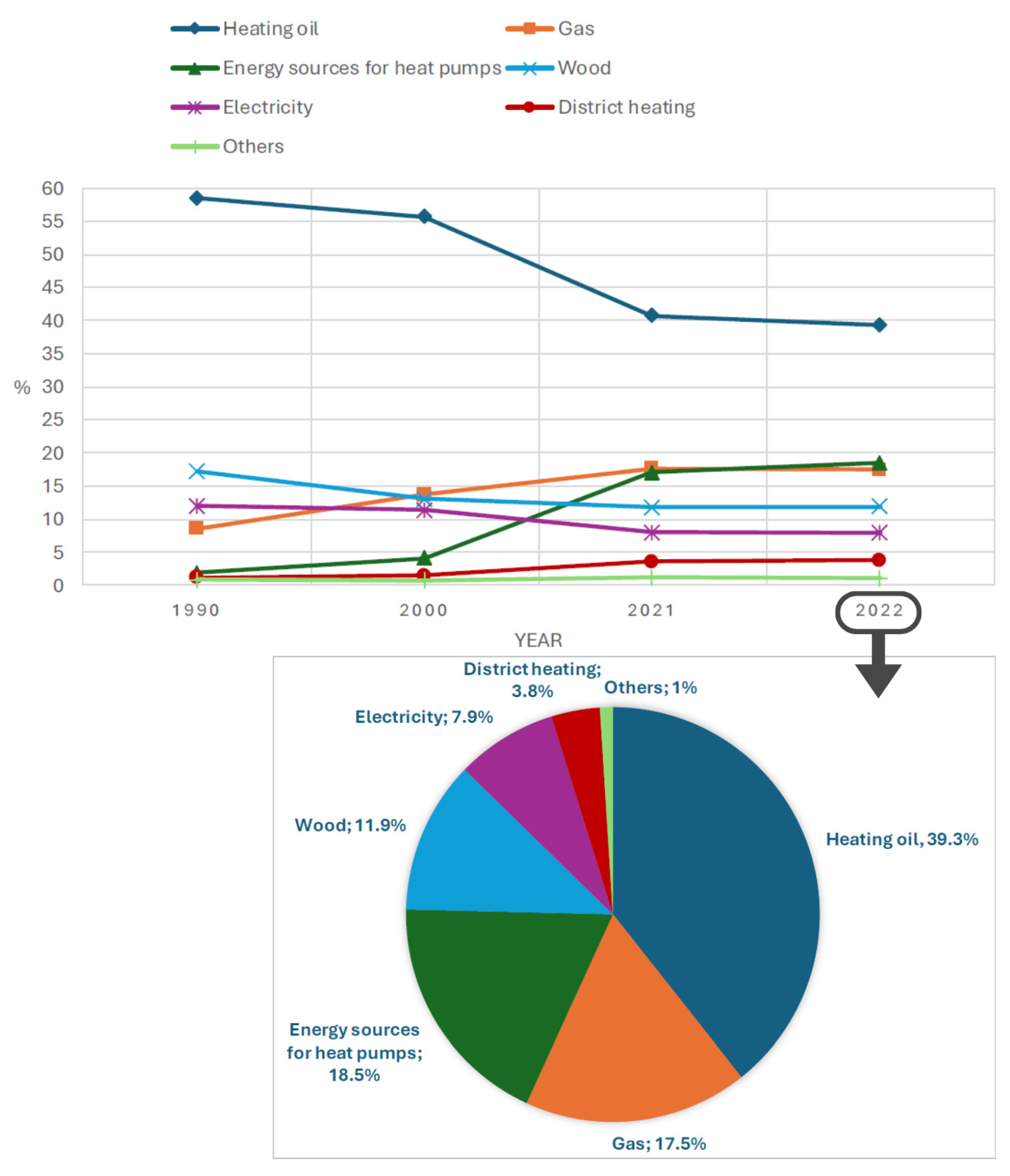
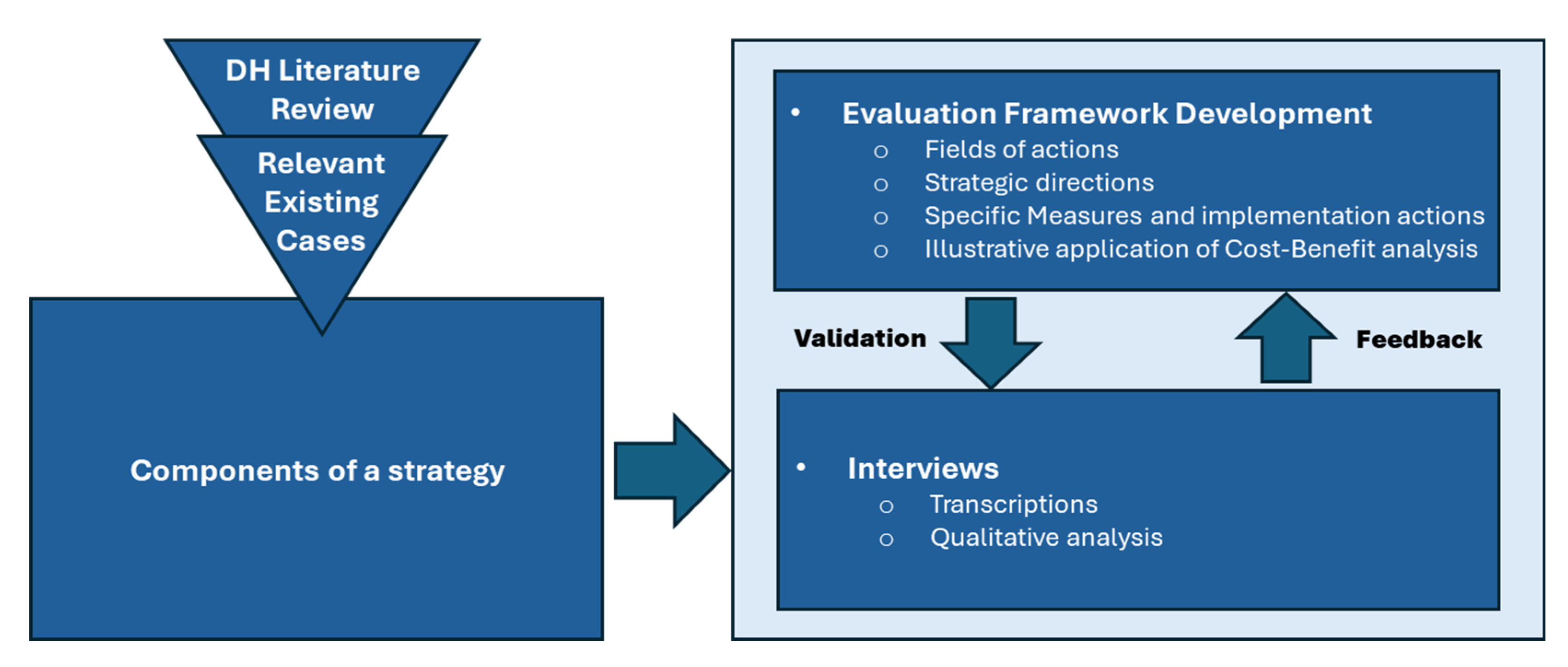
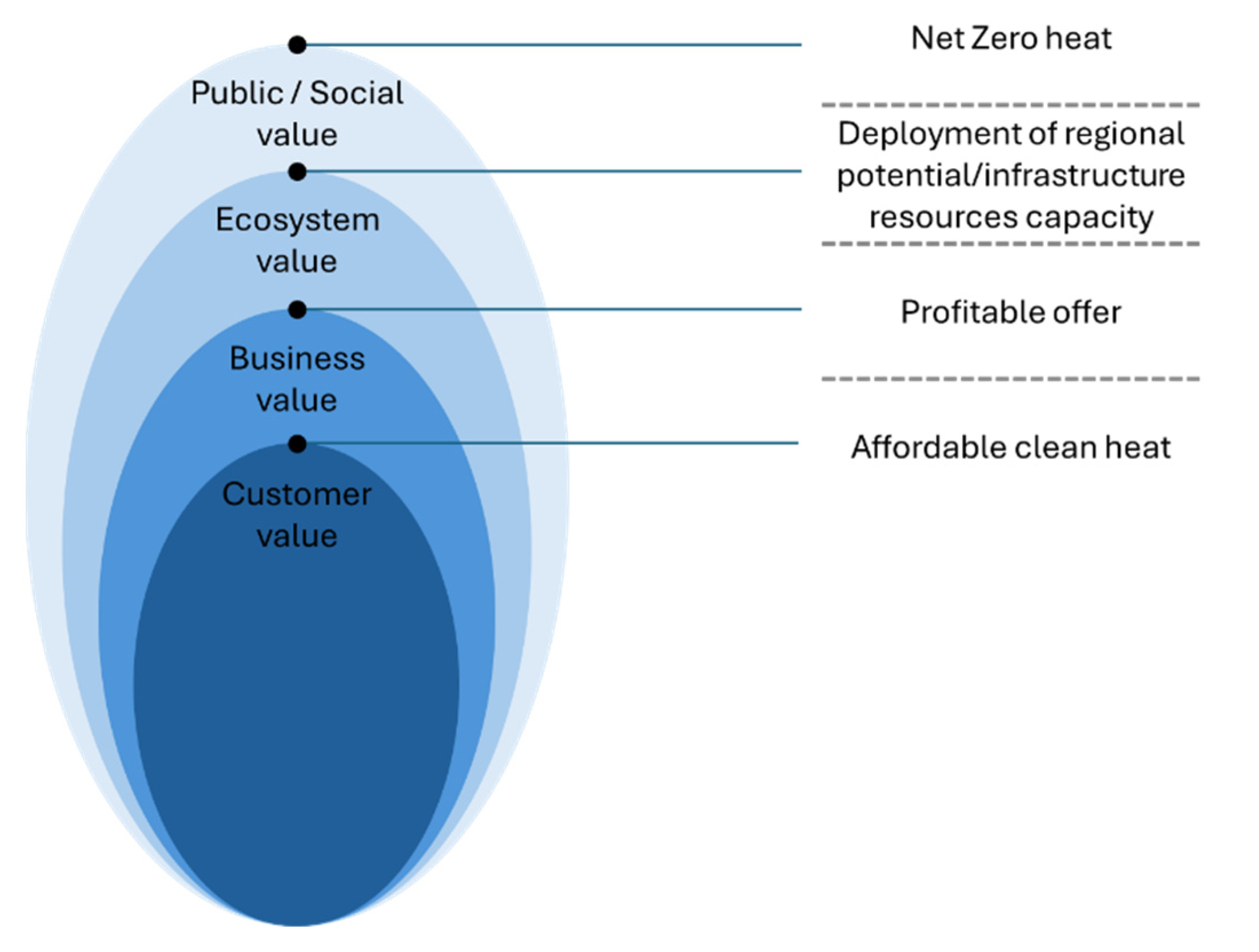
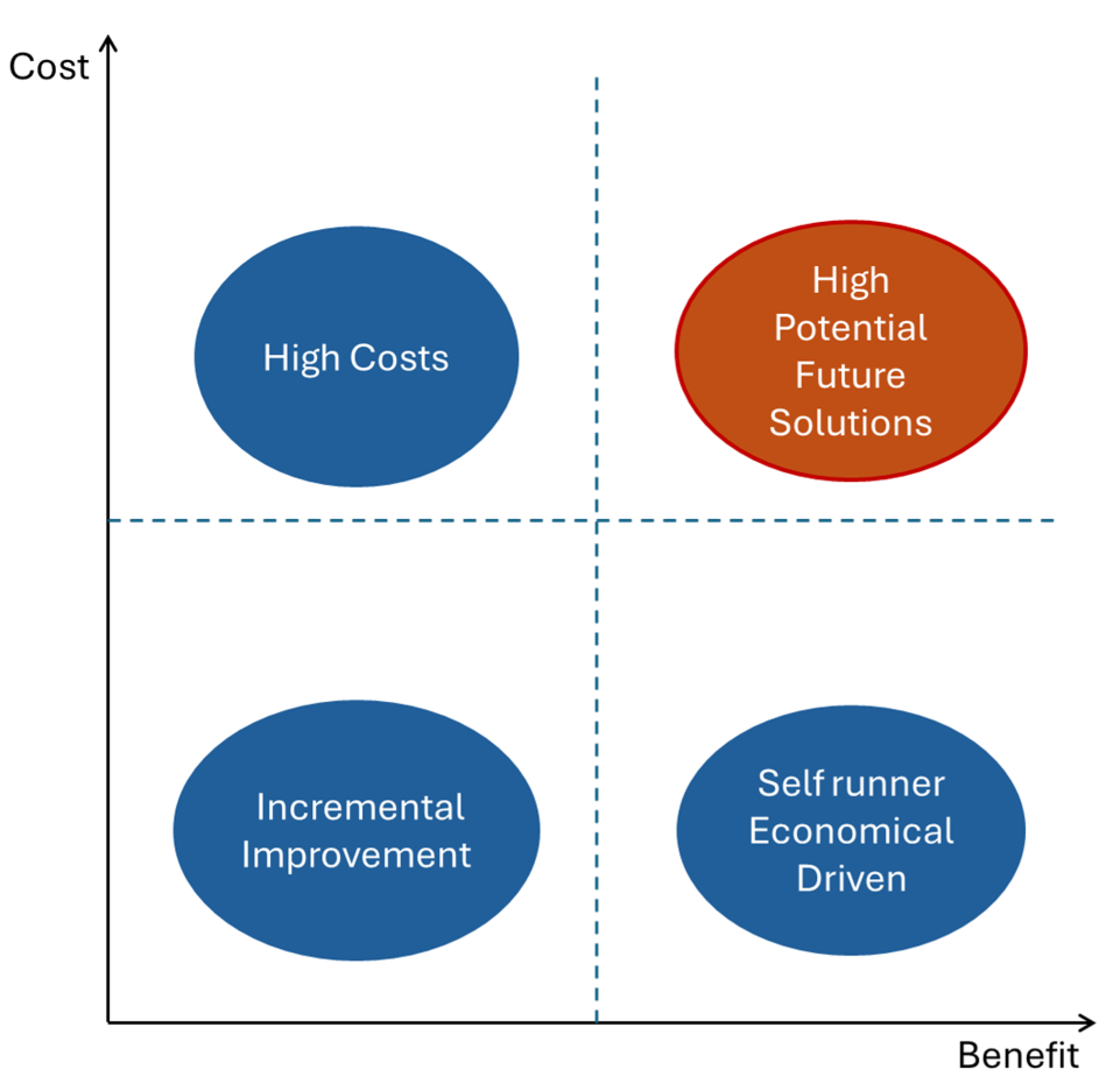
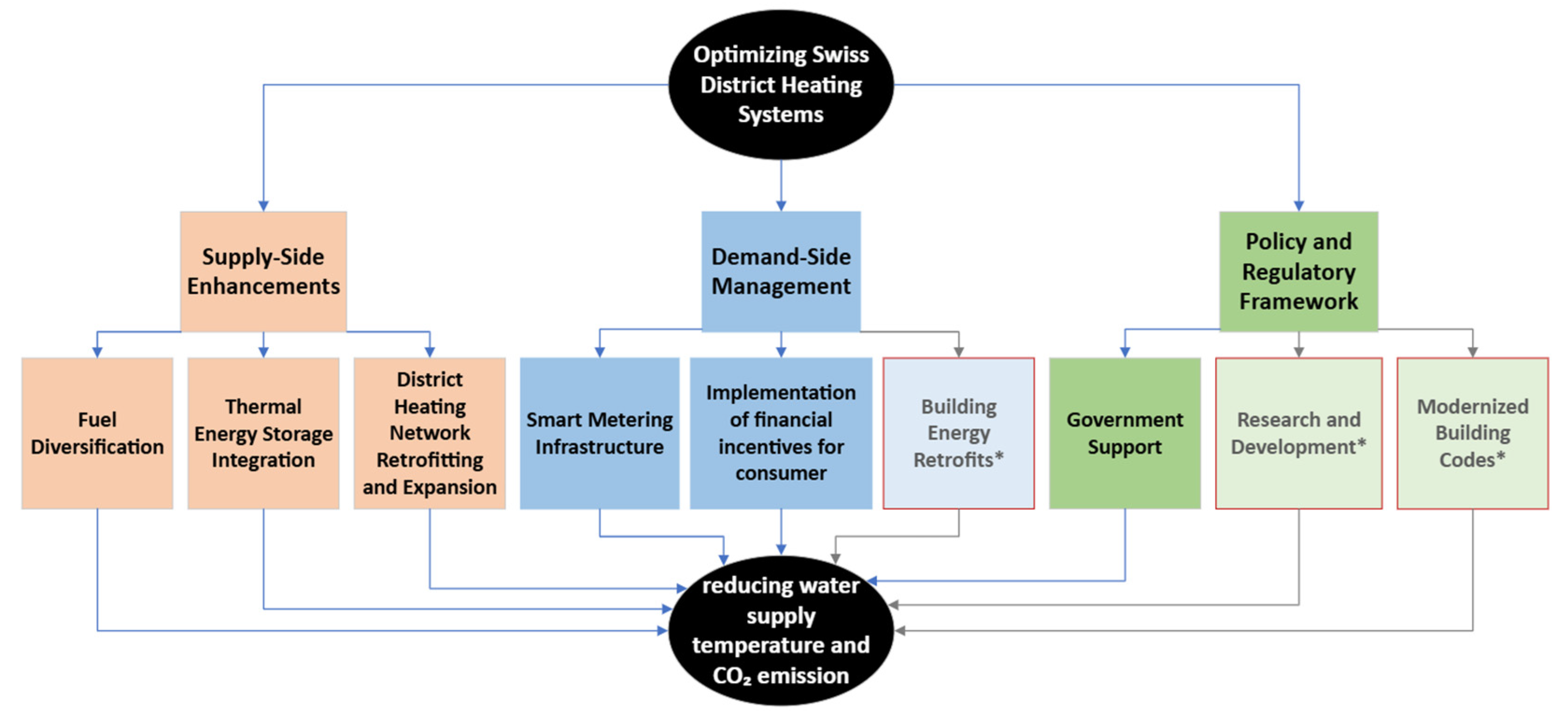
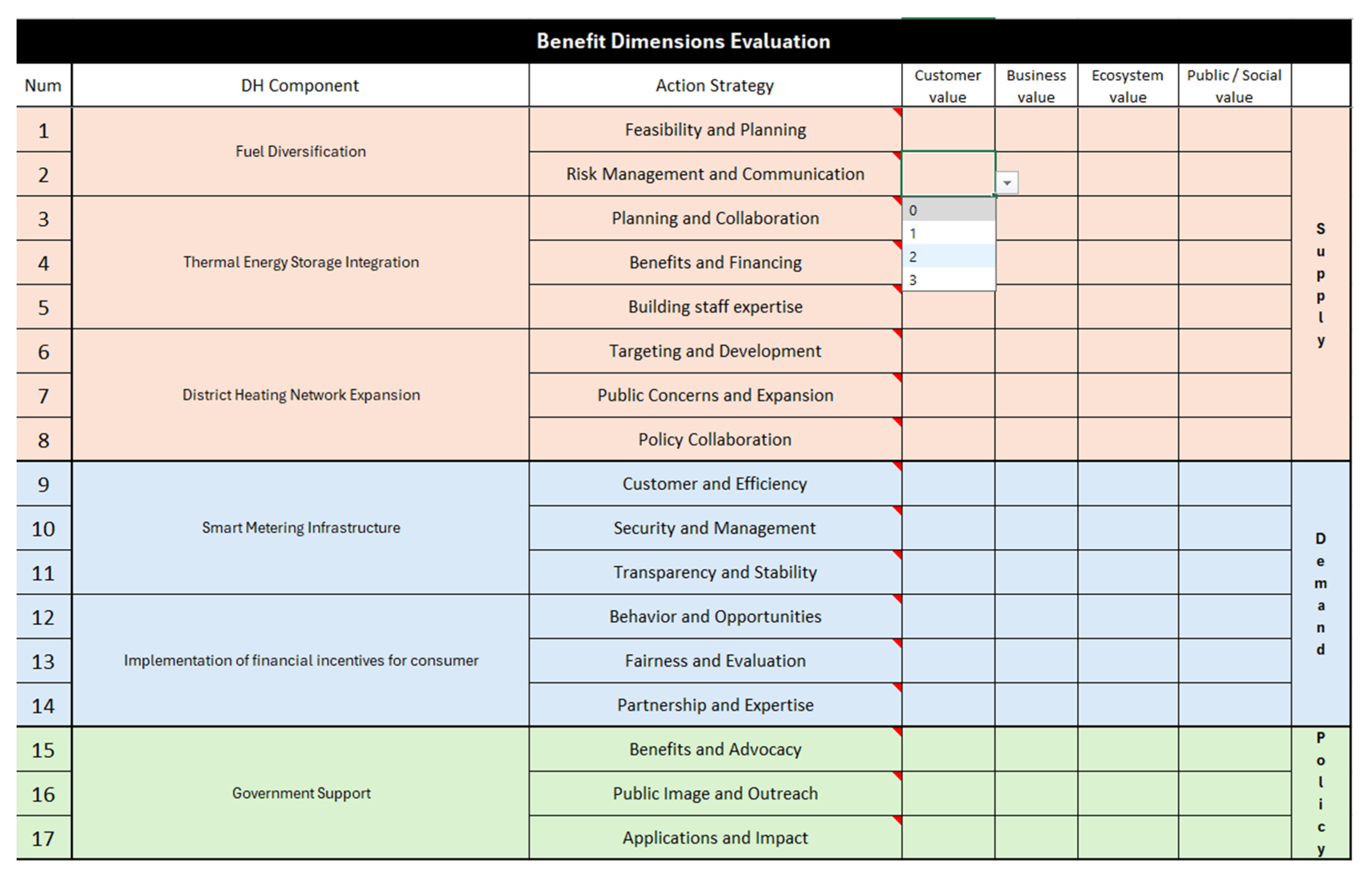
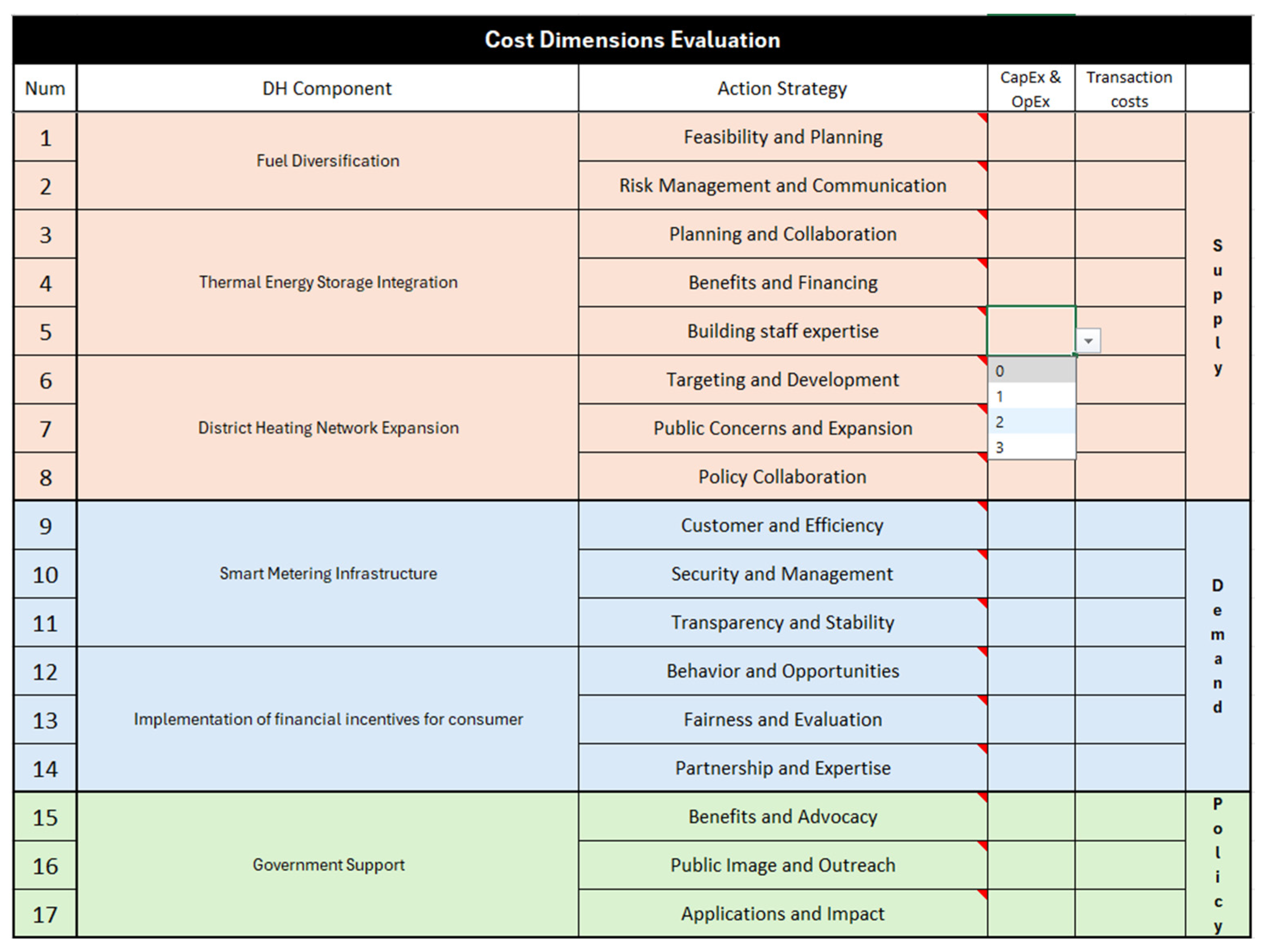
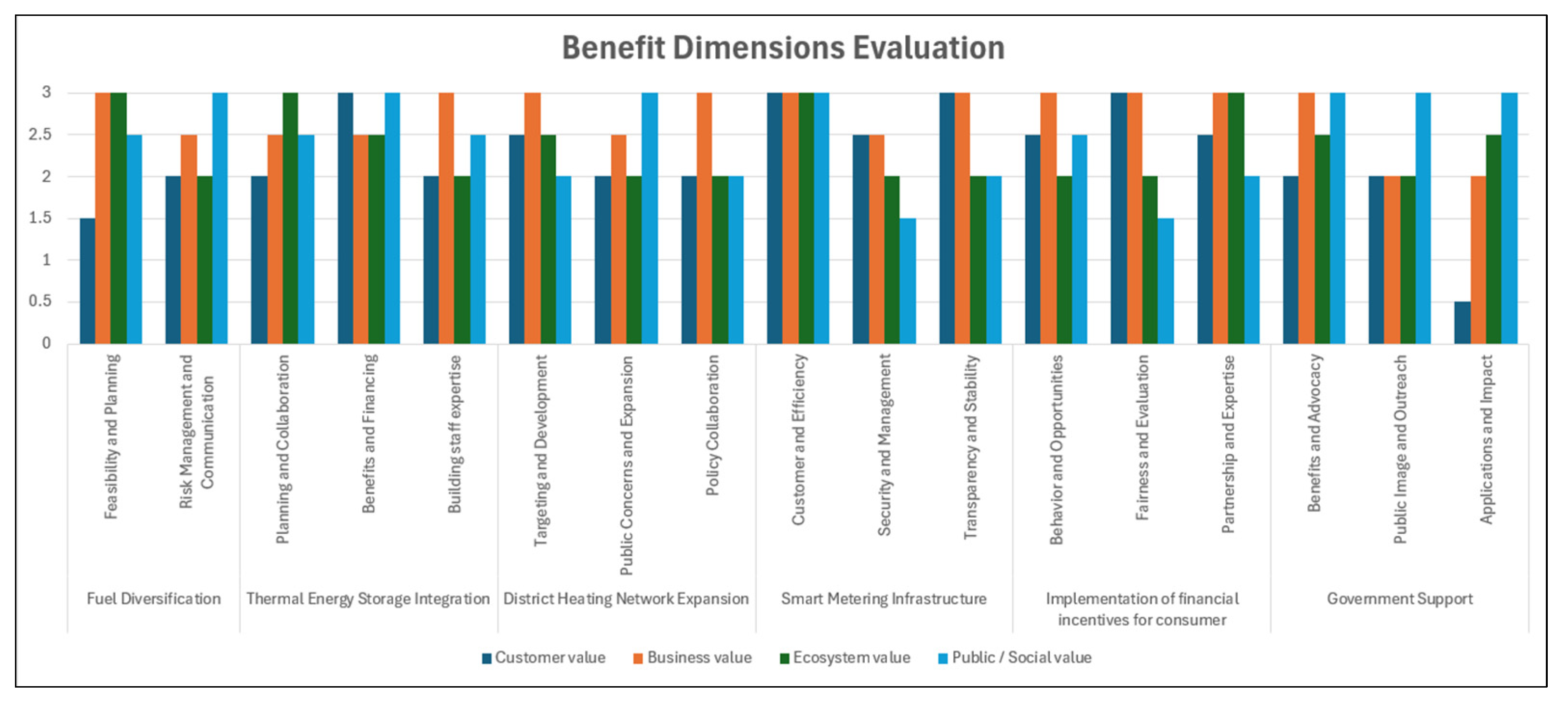
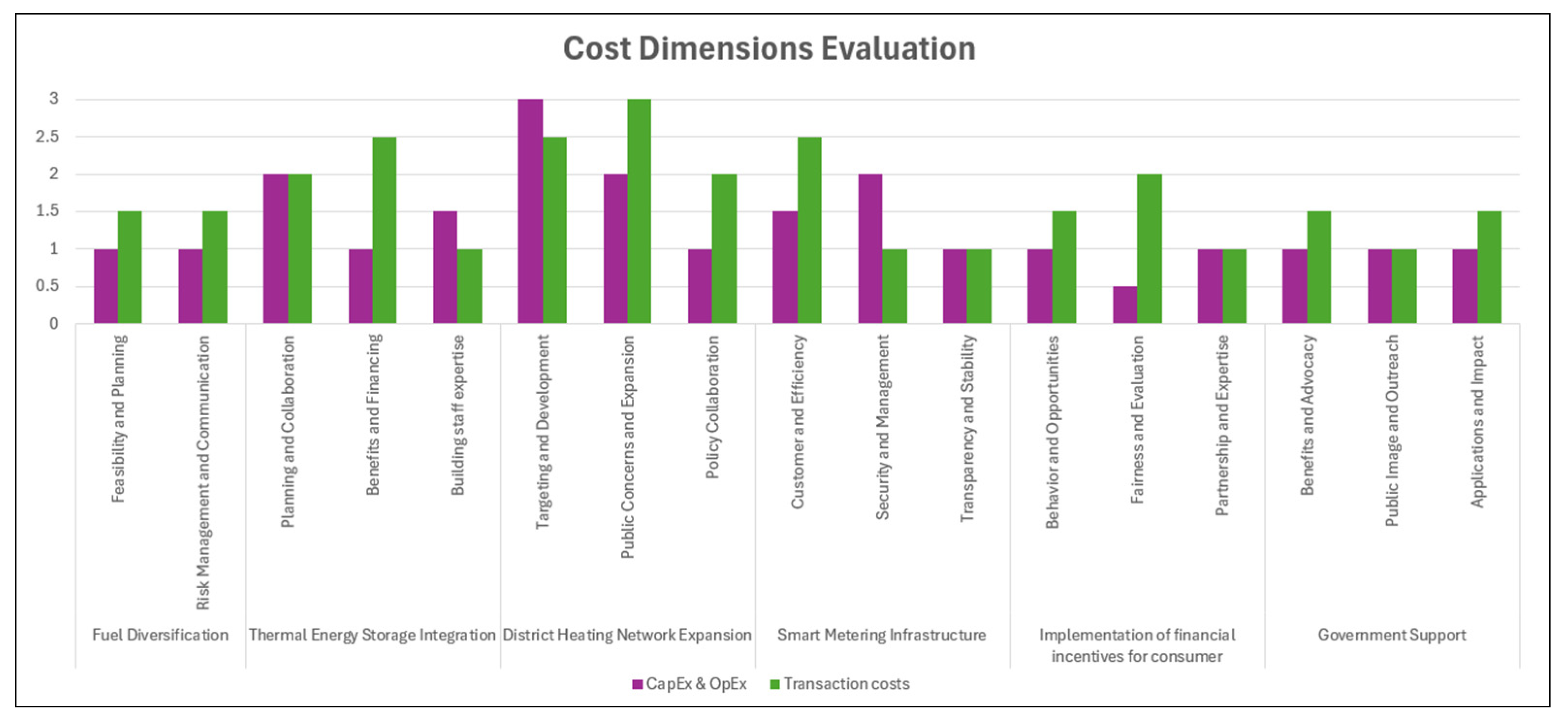
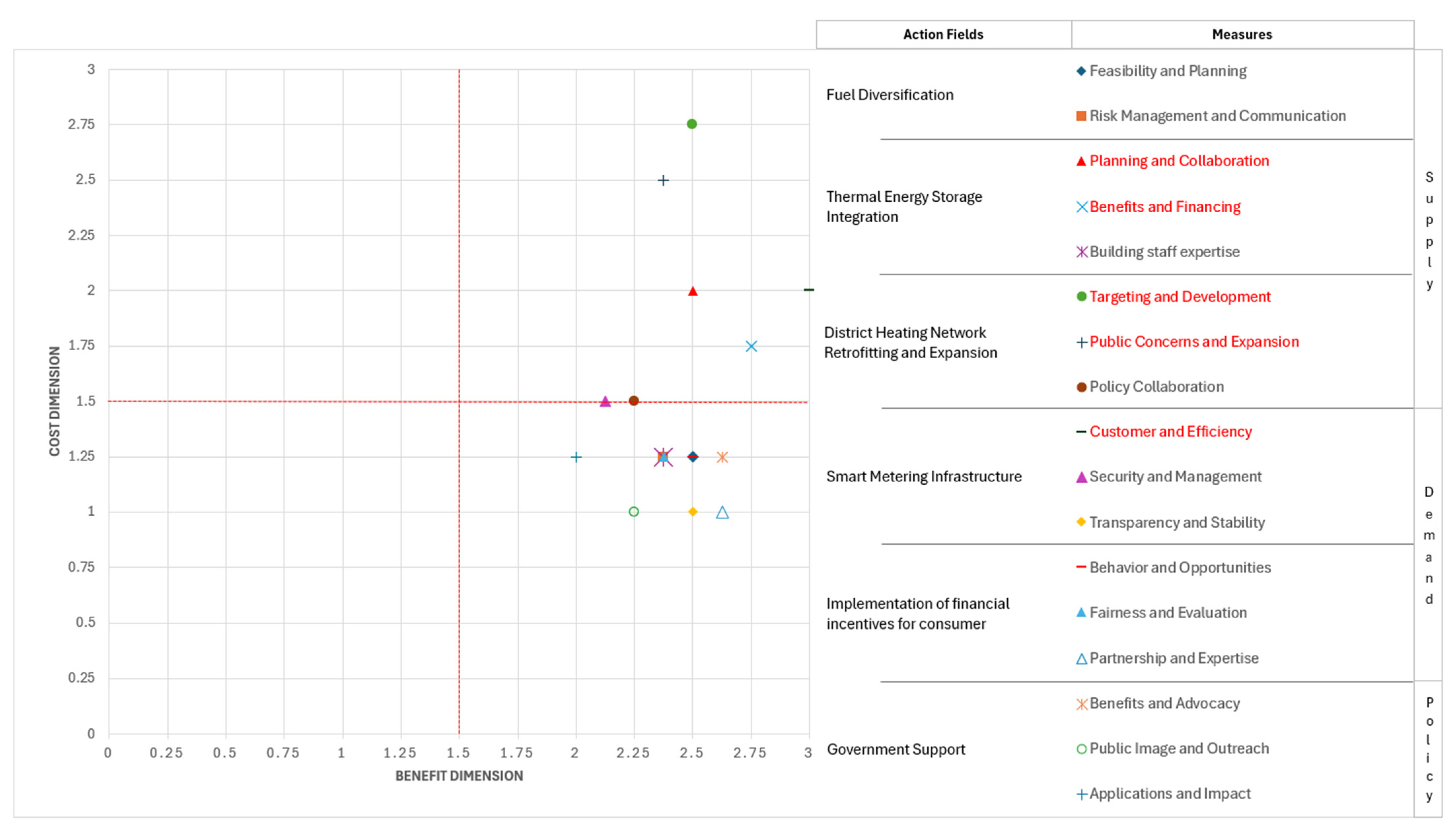
| Keyword | Database | Type of Document | Language | Quantity |
|---|---|---|---|---|
| TS = (“energy” AND “district heating” OR “systems” AND “smart” AND “generation” AND “renewable” AND “sustainable” AND “heat” AND “temperature”) | Web of Science | Journal articles conference papers | English | 39 |
| TITLE-ABS-KEY (“energy” OR “designing” AND “efficiency” AND “program” AND “household” AND “achieve” AND “sustainability”) AND PUBYEAR > 2015 AND PUBYEAR < 2024 AND (LIMIT-TO (LANGUAGE, “English”)) | Scopus | Journal articles conference papers | English | 2 |
| energy district heating systems future temperature generation report networks | Google Scholar | Journal articles conference papers | English | 36 |
| Supply-Side Enhancements Fuel Diversification | |||
|---|---|---|---|
| Internal factors | Strengths (S)
| Weakness (W)
| |
| External factors | |||
Opportunities (O)
| S–O strategy directions
| ||
Threats (T)
| |||
| Supply-Side Enhancements Thermal Energy Storage Integration | |||
|---|---|---|---|
| Internal factors | Strengths (S)
| Weakness (W)
| |
| External factors | |||
Opportunities (O)
| S–O strategy directions
| ||
Threats (T)
| |||
| Supply-Side Enhancements District Heating Network Retrofitting and Expansion | |||
|---|---|---|---|
| Internal factors | Strengths (S)
| Weakness (W)
| |
| External factors | |||
Opportunities (O)
| S–O strategy directions
| ||
Threats (T)
| |||
| Demand-Side Management Smart Metering Infrastructure | |||
|---|---|---|---|
| Internal factors | Strengths (S)
| Weakness (W)
| |
| External factors | |||
Opportunities (O)
| S–O strategy directions
| ||
Threats (T)
| |||
| Demand-Side Management Implementation of Financial Incentives for Consumer | |||
|---|---|---|---|
| Internal factors | Strengths (S)
| Weakness (W)
| |
| External factors | |||
Opportunities (O)
| S–O strategy directions
| ||
Threats (T)
| |||
| Policy and Regulatory Framework Government Support | |||
|---|---|---|---|
| Internal factors | Strengths (S)
| Weakness (W)
| |
| External factors | |||
Opportunities (O)
| S–O strategy directions
| ||
Threats (T)
| |||
| Category | Action fields | Measures | Illustrative Activities |
|---|---|---|---|
| Supply | Fuel Diversification | Feasibility and Planning |
|
| Risk Management and Communication |
| ||
| Thermal Energy Storage Integration | Planning and Collaboration |
| |
| Benefits and Financing |
| ||
| Building Staff Expertise |
| ||
| District Heating Network Retrofitting and Expansion | Targeting and Development |
| |
| Public Concerns and Expansion |
| ||
| Policy Collaboration |
| ||
| Demand | Smart Metering Infrastructure | Customer and Efficiency |
|
| Security and Management |
| ||
| Transparency and Stability |
| ||
| Implementation of Financial Incentives for Consumer | Behavior and Opportunities |
| |
| Fairness and Evaluation |
| ||
| Partnership and Expertise |
| ||
| Policy | Government Support | Benefits and Advocacy |
|
| Public Image and Outreach |
| ||
| Applications and Impact |
|
Disclaimer/Publisher’s Note: The statements, opinions and data contained in all publications are solely those of the individual author(s) and contributor(s) and not of MDPI and/or the editor(s). MDPI and/or the editor(s) disclaim responsibility for any injury to people or property resulting from any ideas, methods, instructions or products referred to in the content. |
© 2025 by the authors. Licensee MDPI, Basel, Switzerland. This article is an open access article distributed under the terms and conditions of the Creative Commons Attribution (CC BY) license (https://creativecommons.org/licenses/by/4.0/).
Share and Cite
Bahadori, R.; Speich, M.; Ulli-Beer, S. Modernizing District Heating Networks: A Strategic Decision-Support Framework for Sustainable Retrofitting. Energies 2025, 18, 3759. https://doi.org/10.3390/en18143759
Bahadori R, Speich M, Ulli-Beer S. Modernizing District Heating Networks: A Strategic Decision-Support Framework for Sustainable Retrofitting. Energies. 2025; 18(14):3759. https://doi.org/10.3390/en18143759
Chicago/Turabian StyleBahadori, Reza, Matthias Speich, and Silvia Ulli-Beer. 2025. "Modernizing District Heating Networks: A Strategic Decision-Support Framework for Sustainable Retrofitting" Energies 18, no. 14: 3759. https://doi.org/10.3390/en18143759
APA StyleBahadori, R., Speich, M., & Ulli-Beer, S. (2025). Modernizing District Heating Networks: A Strategic Decision-Support Framework for Sustainable Retrofitting. Energies, 18(14), 3759. https://doi.org/10.3390/en18143759






